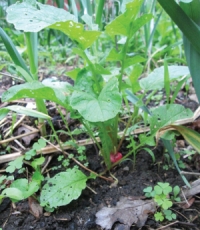To give you an example from my garden: the radish! The radish is always one of the first crops to be harvested in the spring, seeing as they take around 30 days to grow until harvest. Instead of growing only lettuce in rows, I like to alternate rows of radishes (deep roots) with lettuce (shallow roots) to maximize space and minimize weed growth. This way, when I harvest the radishes, the lettuce plants are given more light and space to spread out and grow before harvest. In the rows where the radishes grew, add some finished compost and sow some carrots. They typically take a week or longer to germinate and will begin to grow more rapidly as you harvest your lettuce. The combinations for succession planting are many.
In a similar fashion to succession planting, instead of fighting weeds in my garden in the spaces between tomato and pepper plants, I like to sow a fast growing cover crop like buckwheat to add bio matter to my garden. The benefits of sowing buckwheat in the garden are many. Among them is its ability to attract beneficial, predatory insects, fix phosphorous and suppress weeds. Consider sowing a series of small cover crops throughout the summer in and around your garden. Click here for ideas on how to begin and options to consider!

Buckwheat sown among peppers
Lastly, I recently made a connection with an organization called Ample Harvest which connects gardeners to their local food pantries. The idea behind the organization is that there is more than enough food grown in backyard gardens, community gardens and other gardens to provide hungry folks in our city with fresh vegetables and fruits during a great portion of the year. Ample Harvest connects the two entities by providing gardeners with a place to donate their food. In fact, there are more than 18 places in the Milwaukee area where you can donate your extra produce grown in your gardens. After planning out your succession planting and cover cropping schedule for the summer, think about how you can donate to the local food pantry too! It is going to be a great growing season!





